Expert’s Rating
Pros
- Excellent edge cleaning
- Won’t bump into pets or kids
- Whole machine HEPA filtration
Cons
- Poor battery life
- Inaccurate mapping
- Noisy
Our Verdict
Dyson rarely misses, but this is one of those times. In spite of its impressive vacuuming ability and clever edge-cleaning technology, the 360 Vis Nav is so slow, error-prone and noisy that it’s a chore to use.
Price When Reviewed
U.S. pricing and availability TBD
Before I had the chance to test the 360 Vis Nav for myself, I was invited to see it in action. Dyson explained that they saw it primarily as a mobile, hands-free vacuum, and that they’d put their efforts into making it into a brilliant cleaner.
Fair enough, I thought to myself. Yes, it’s breathtakingly expensive, especially for such a limited feature set – but hey, it’s a Dyson. If it does its job to a high standard, there are always people willing to pay for the best.
But then I tested it. Here’s what happened.
Design and Build
- Easy to remove filter and dustbin
- Low profile at 99mm
- Camera-based navigation
The 360 Vis Nav has a characteristic Dyson design. Its matt blue finish, stripy roller and distinctive shape ensure that it won’t blend into the background. If you’re going to spend north of a grand on a robot vacuum that doesn’t mop, empty or clean itself, then perhaps – at the very least – you want people to notice it. But as Dyson has opted not to add bumpers, it likely won’t be pristine for long: during testing, it quickly picked up a few scratches and scapes.
In true brand style, Dyson has innovated when it comes to the robot vacuum’s build. Unlike most competitors, the 360 Vis Nav is not a featureless disc. It’s flat-fronted, with a wide brush bar that can clean both carpets and hard flooring. Instead of a spinning sweeper, it has a side duct to which a portion of its suction power is diverted, to help it clean right up to walls and into corners.
It also has a full-colour touchscreen on top to display current action and in-depth troubleshooting information.
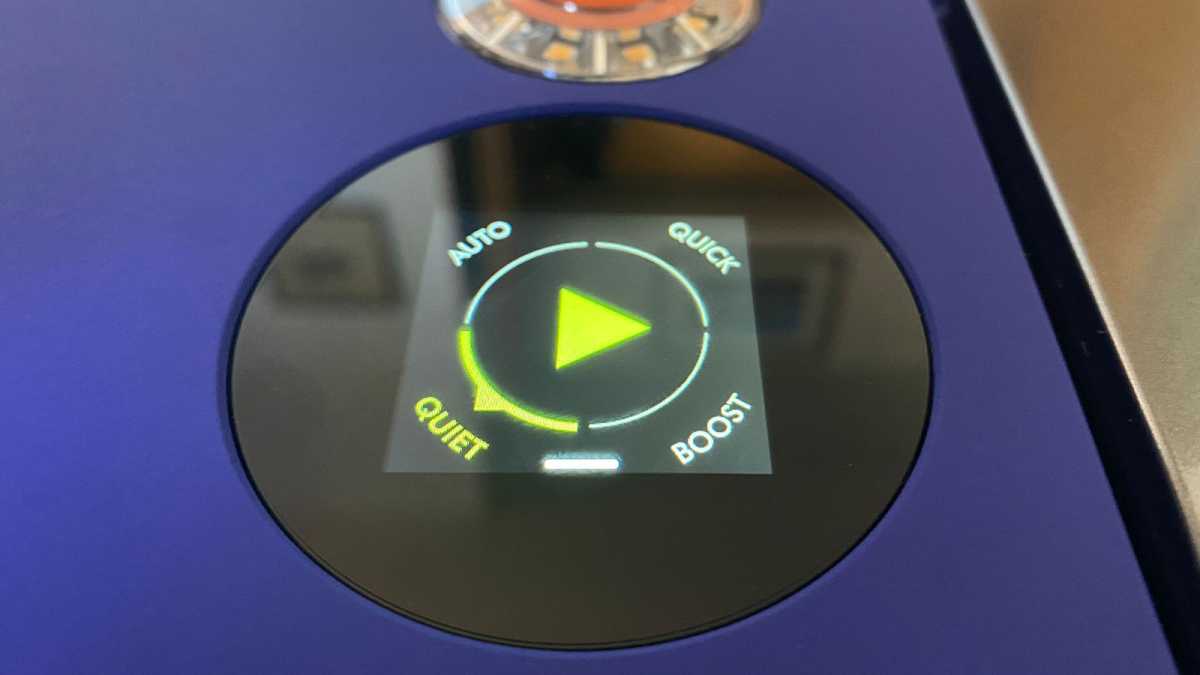
Emma Rowley / Foundry
It features an easy-access filter and bin, both of which pop out from the top of the robot. The bin is cylindrical and can be carried to the kitchen with its own little carry handle and both can be washed by hand. These features make it easy to maintain.
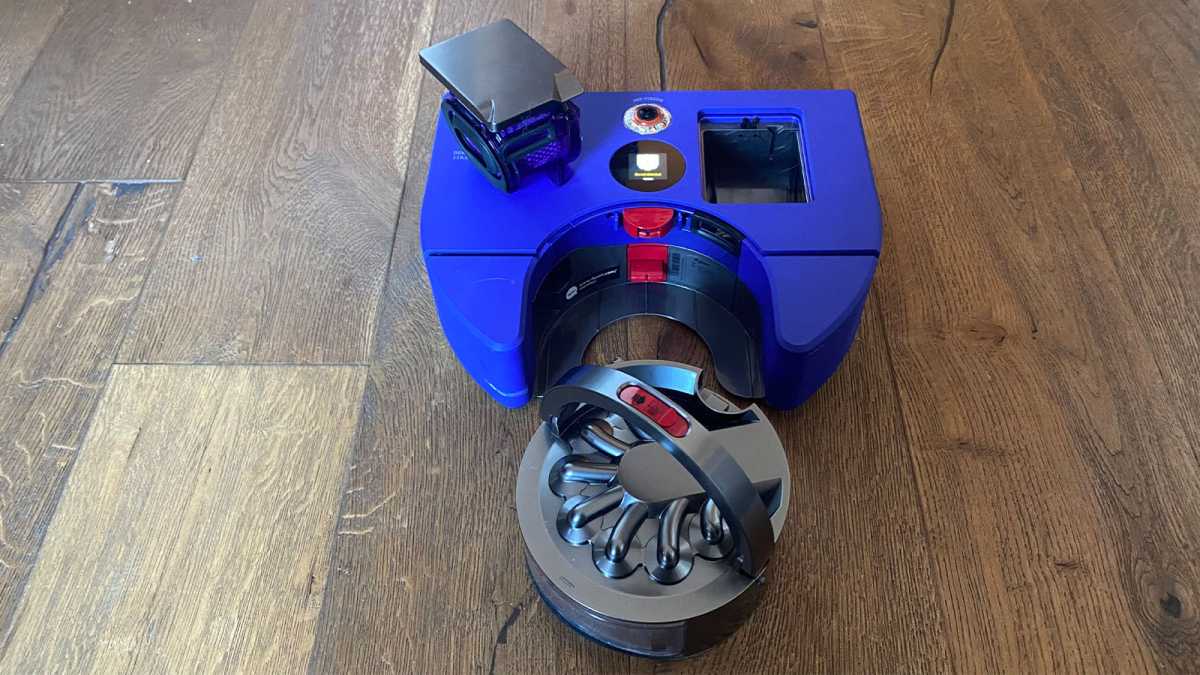
Emma Rowley / Foundry
On top of the robot, front and centre, is an embedded fish-eye camera lens, with a 360-degree field of vision (hence the name). This means that unlike most competitors, it’s not primarily using laser-based navigation. You’ll spot the first disadvantage of this system when it ventures into a dimly-lit room: it needs to switch on a light ring around the camera to help it to see.
But it doesn’t entirely rely on the camera. It has a total of 26 sensors to navigate, including time of flight sensors to detect objects around it and drop sensors to stop short of stairs.
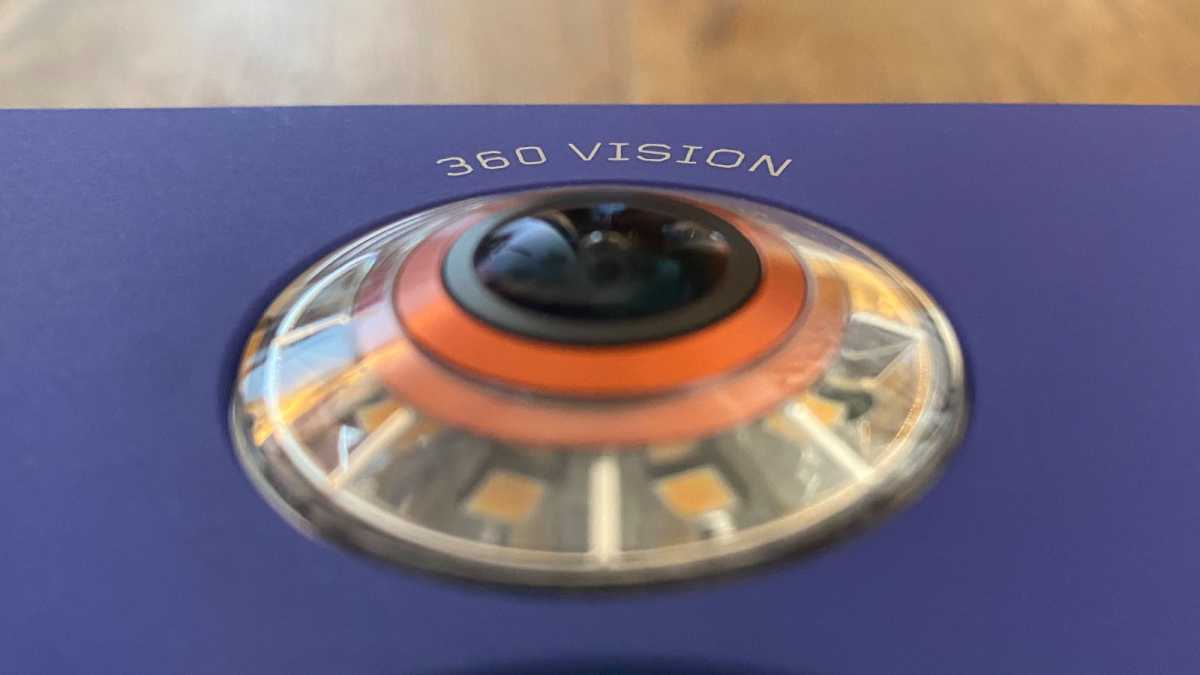
Emma Rowley / Foundry
With a fairly low profile of only 99mm high, it should be able to get under your bed and sofa to vacuum. That is, if it can find them – but I’ll come back to this.
As you’d expect, the build quality is top notch. When you’ve just unboxed it and set it up, you’d be tempted to think you’d got your money’s worth. How very wrong you would be.
Performance and Features
- Alexa and Google Home compatible
- Mapping unreliable
- Four cleaning modes
Setting up the 360 Vis Nav is a piece of cake. Plug in the dock, which is fairly compact and therefore easy to find a home for. Then download the MyDyson app for iOS or Android, and it’ll walk you through the set-up process. It’ll even automatically connect to your Alexa app, should you have one. (It also support Google Home.) The MyDyson app itself is clearly laid out and a pleasure to use.
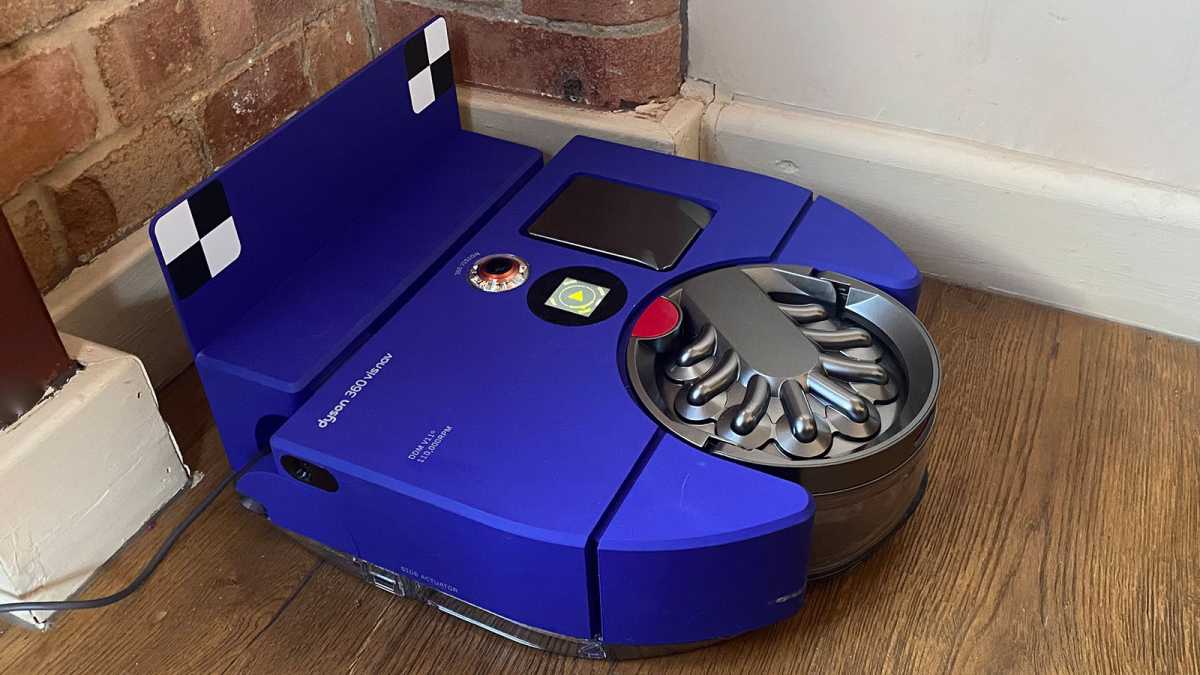
Emma Rowley / Foundry
The 360 Vis Nav is priced to sit among the top tier of robot vacuums, competing with the likes of Ecovacs’ T20 Omni, whose feature set is too extensive to go into here but includes mopping with hot water, cleaning its mops pads, emptying its onboard bin and responding to voice commands via its dedicated voice assistant.
In comparison, the 360 Vis Nav does one thing: it vacuums well. But if it can’t get to the spots that need vacuuming, that becomes moot.
Once you’ve got a robot vacuum set up, the first thing to do is send it out on a mapping run. Some robots map and vacuum at the same time. Others need a dedicated run. Either way, it’s not much of a hassle. Off it goes, and it comes back with a fairly accurate map that you then edit (altering room thresholds) and annotate (naming rooms).
The Vis Nav’s first mapping run went spectacularly awry. It wasn’t even able to find its dock at the end, instead spinning woozily around until it ran out of battery life.
The map it produced was bizarre, with half of my flat missing and the dock positioned in the middle of the room. (It wasn’t, and nothing had been moved.)
The 360 Vis Nav does one thing: it vacuums well. But if it can’t get to the spots that need vacuuming, that becomes moot
Well, never mind. Anyone can have a bad five minutes. The second mapping run was better, as the robot was at least able to find the kitchen and bathroom that time.
The bedroom was more complicated. There’s a wide, raised threshold at the bedroom door, which was a problem for your average robot vac a few years ago, but times have changed and newer models can cope with it.
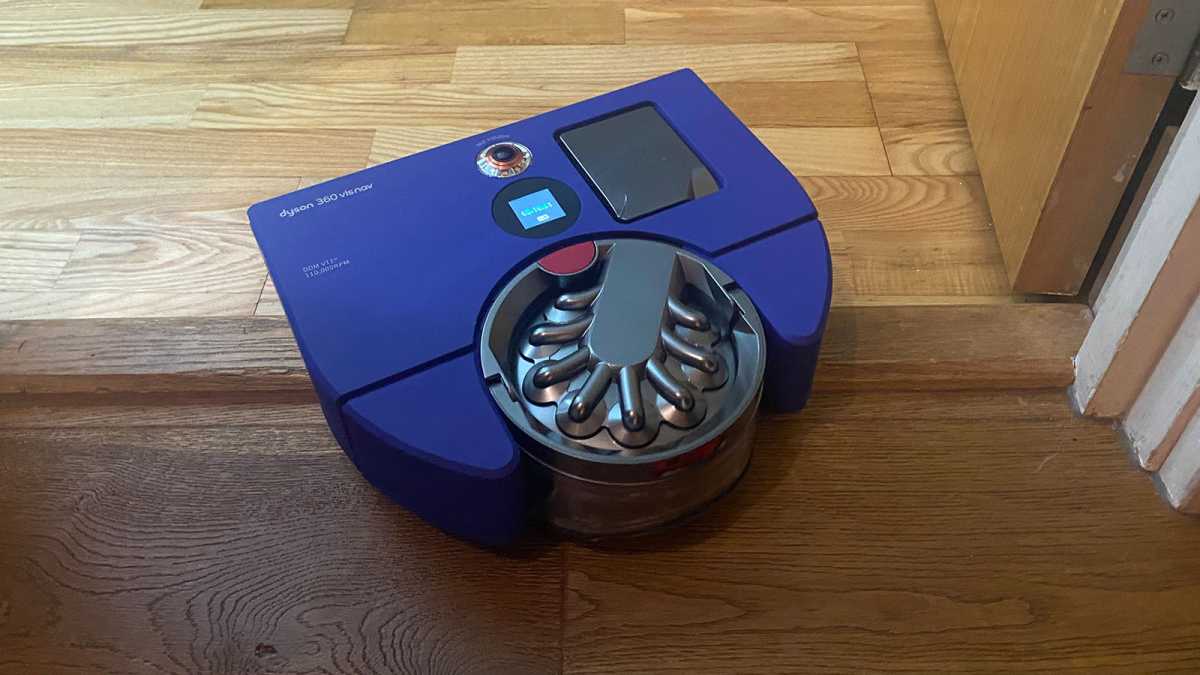
Emma Rowley / Foundry
The Vis Nav is advertised as having good climbing ability, so I didn’t anticipate a problem. But it beached itself straight away. I observed it flailing hopelessly around for a good four or five minutes with the same sadness that David Attenborough must feel when he sees a baby seal that’s just not going to make it to summer.
So, it won’t be cleaning the bedroom. Not the end of the world. But when the robot returned to the dock and the map was made, half the living room was missing as well.
On the third mapping run, it did get into the bedroom (although it needed a rescue to get out again) but lost the bathroom and kitchen again, and a chunk of the sitting room was missing.
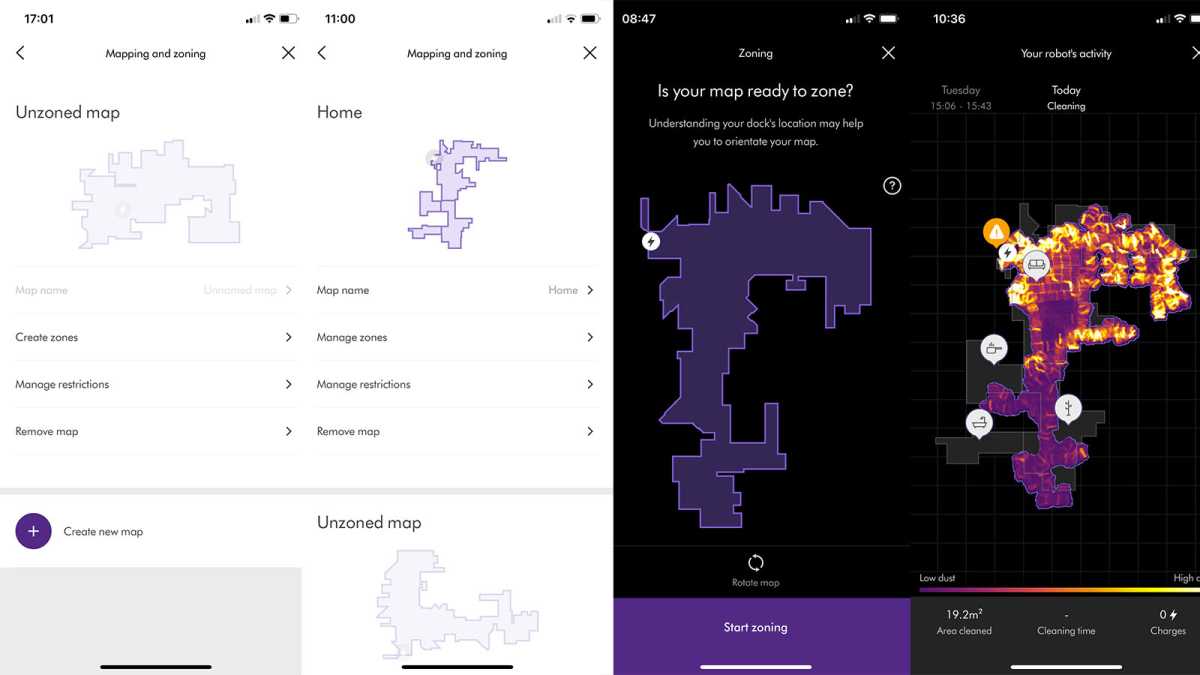
Foundry
That’s when I gave up on mapping. I picked one of the maps I’d made and sectioned off and named rooms. This allows you to set up exclusion zones, and send or schedule the robot to clean specific rooms.
Battery life is another issue. It has a stated maximum runtime of 65 minutes, but that’s a stretch. A 22-minute clean in Auto mode used more than two-thirds of the battery life. It’s unlikely that it would manage to make a full circuit of a larger home without running out of battery life completely and needing to return and recharge. This is just not in line with the performance of rivals.
When it cleans, it’s excellent. The problem is that it’s such a nuisance in every other respect
Part of the reason it’s so power-hungry may be the 360 Vis Nav’s hesitant manner. It pauses, recalibrates and changes direction more than any other robot vacuum I’ve seen, which make its cleaning rounds slow going.
In some instances, this is useful. It will never bang into your ankle – and your cat will be perfectly safe around it – but it still has irritating navigational blind spots, such as low objects and cables.
It’s pretty galling to watch it tentatively change its angle three or four times, only to cheerfully plough into some pet bowls and slop water all over the floor. And according to Dyson, it should be able to unwrap cables that tangle around it, but it doesn’t always work in practice.
On to cleaning. As promised, the 360 Vis Nav is a very effective vacuum, with excellent edge cleaning. I set it some difficult tasks, including picking up flour sugar spilled along a wall, which it completed almost flawlessly. Thanks to its HEPA filtration, it doesn’t vent any dust back out either.
Dyson claims that it’s the most powerful robot vacuum cleaner on the market, with 65AW of suction. Still, it’s hard to compare its on-paper performance to rivals as every other robot vacuum brand uses Pascals as their key metric.
It has four cleaning modes: Quick, Quiet, Boost and Auto. In Quick, it’ll do a run through the busiest areas of a room. Quiet mode is a misnomer: it makes a lot of rackety mechanical noise, especially on hardwood flooring. Auto is the mode you’ll want it in most of the time, so the robot can turn up the power when needed. Boost mode is just for spills and you won’t get more than a few minutes’ battery life from it.
When it cleans, it’s excellent. It does a much better job on carpets than most rivals, although it won’t mean you can chuck out your vacuum cleaner. The problem is that it’s such a nuisance in every other respect: slow, noisy and bumbling.
I realise that I haven’t mentioned the one unusual feature of the 360 Vis Nav. It produces a dust map of your home each time it cleans. I didn’t know what to do with this during testing and I don’t know what to say about it now, except that it’s far from a must-have feature.
Price and Availability
The 360 Vis Nav is available from Dyson in the UK for £1,199. It’s not yet available in the US, although you can sign up on the Dyson website to find out when it will be.
This makes it among the most expensive robot vacuums you can buy right now. For the same amount of money – or less – you can get a robot vacuum that you can send out with a voice command to precisely clean only under your kitchen table (the iRobot Roomba i7+), after which it will empty its own bin. You could get one that’ll mop your floors, lift its mops if it crosses carpet and then cleans the mop pads when it’s done (the Ecovacs T20 Omni). You could even just use half the money and get an excellent self-emptying vacuum with mop (the Eufy X8 Pro) and spend the rest on a spa day.
Should you buy the Dyson 360 Vis Nav?
I think you know what I’m going to advise. It’s tempting to say that a lot of the Vis Nav’s performance issues could be fixed with software updates – which Dyson is indeed planning. However, that’s not a reason to buy.
For its extraordinary price, it should deliver extraordinary performance. That’s not the case and we wouldn’t recommend you spend your money on it.
To see some of our top recommendations, have a look at our round-up of the best robot vacuums around.
Specs
- Dimensions: 99 x 330 x 320mm
- Weight: 5kg
- Dustbin size: 0.5l
- Charging time: 2.75 hours
- Battery life: Up to 65 mins
- Suction: 65AW
- 4 cleaning modes
